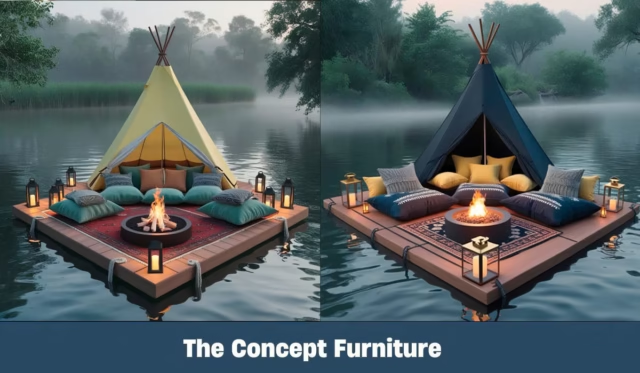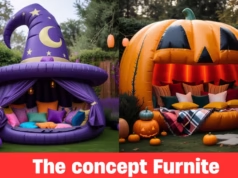Imagine camping on a gentle lake or a lazy river, waking up to views of open water, and listening to the sounds of nature surrounding you. A floating campsite offers all this and more, combining the best of camping and water exploration. This article will take you through everything you need to know about setting up and enjoying a floating campsite. Let’s dive into how to create an extraordinary experience out on the water.
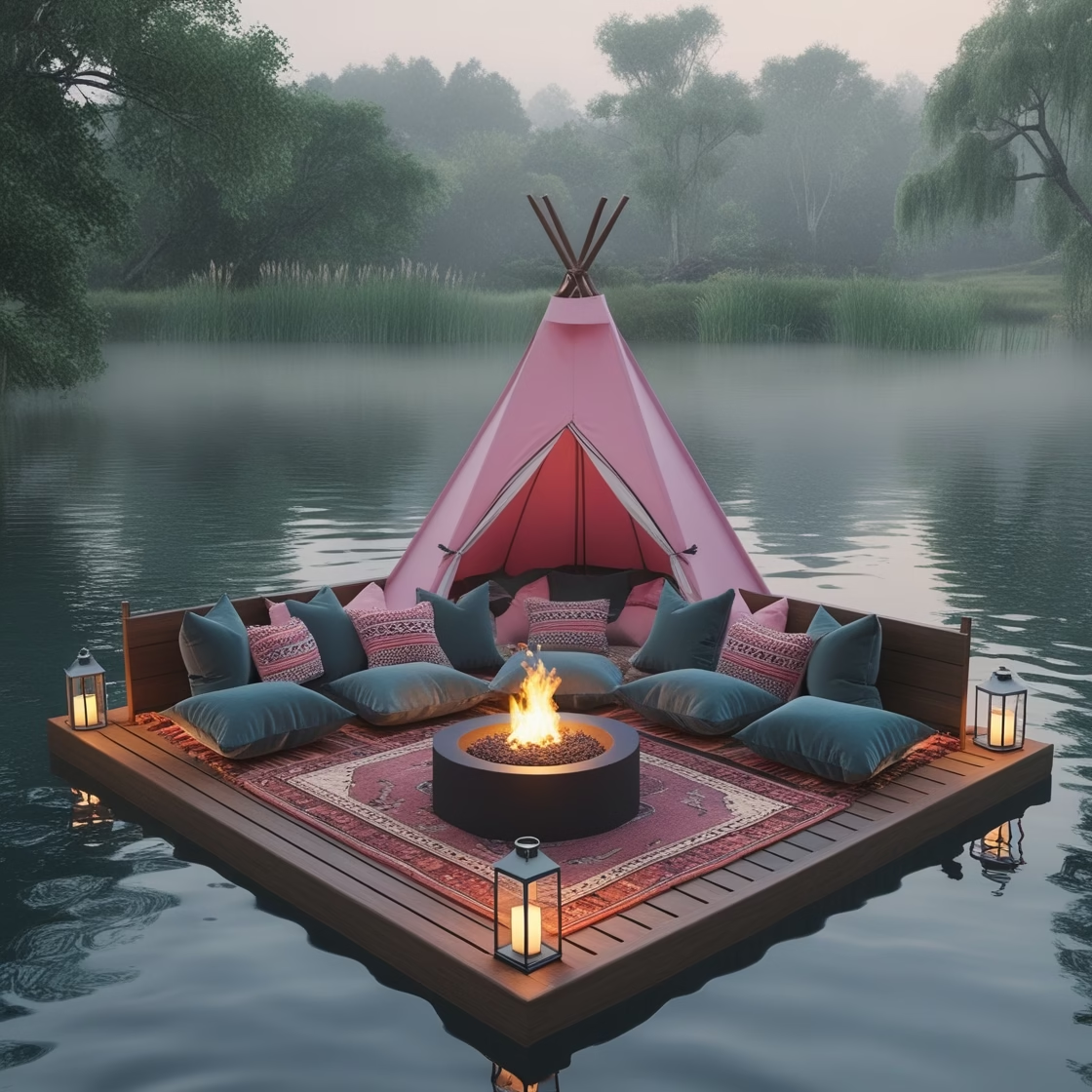
What is a Floating Campsite?
A floating campsite is essentially a portable, water-based camping setup, typically anchored on a lake or river. Campers use floating platforms, rafts, or even pontoon boats as their base, allowing them to camp on water instead of solid ground. This unique approach to camping opens up incredible views, natural sounds, and wildlife interactions that are distinct from traditional land camping.
Why Choose a Floating Campsite?
Floating campsites offer a fresh, exhilarating way to experience the outdoors. Here’s why campers and adventurers are drawn to floating campsites:
- Unmatched Views: With a 360-degree view of open water and surrounding landscapes, floating campsites provide breathtaking sunrise and sunset views.
- Peaceful Environment: The gentle rocking of the water creates a calming environment, ideal for unwinding and enjoying nature.
- Unique Wildlife Encounters: Campers often see aquatic birds, fish, and other wildlife that are less common on land.
- Privacy and Seclusion: Being anchored on water provides more seclusion and privacy compared to crowded land campsites.
Choosing the Right Location for Your Floating Campsite
Types of Water Bodies Suitable for Floating Campsites
Selecting the right water body is essential to setting up a floating campsite that’s safe, stable, and enjoyable. Here are a few options:
Lakes and Reservoirs
Lakes and reservoirs are ideal for floating campsites because of their calm and often predictable waters. The absence of strong currents makes them safer, especially for families or first-time floating campers.
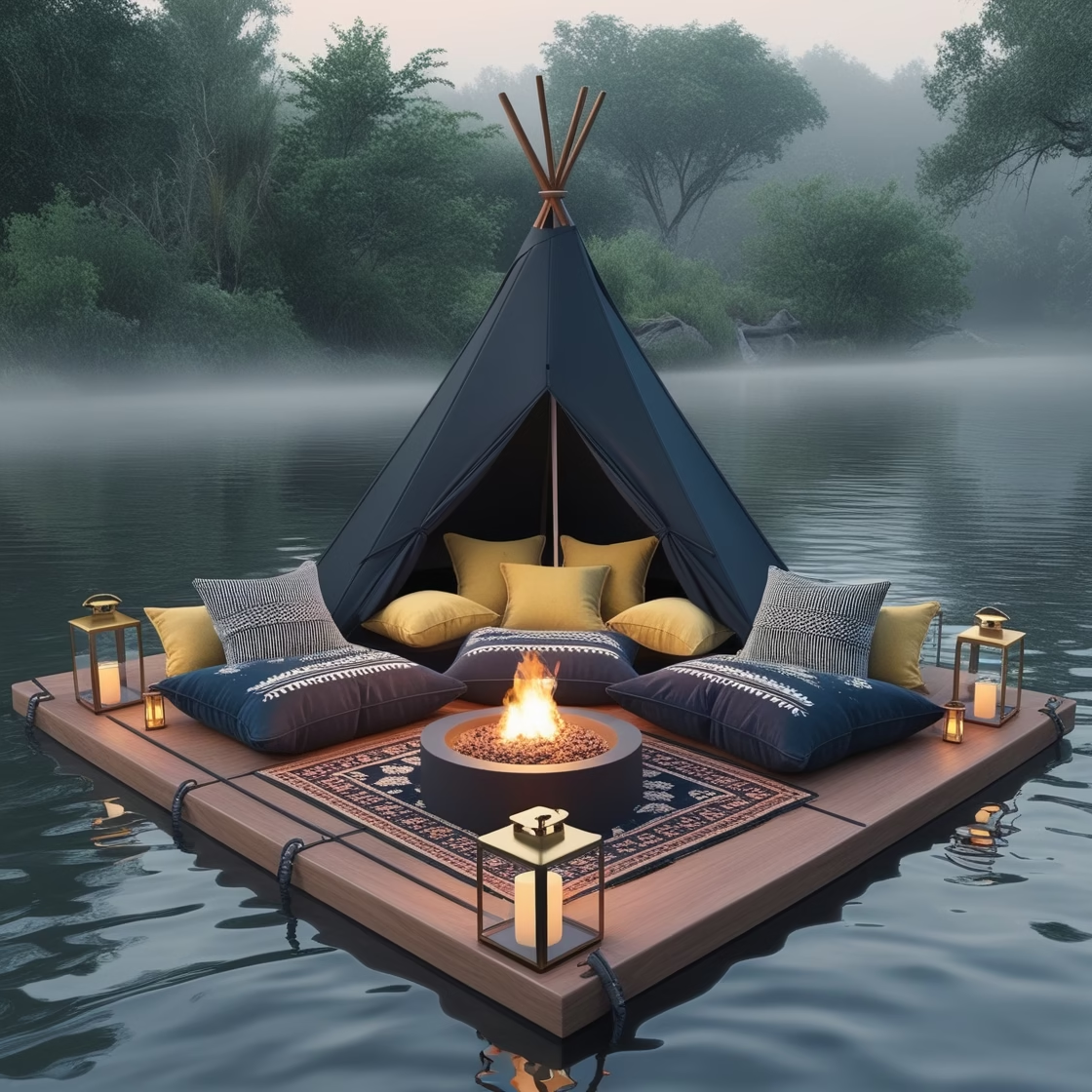
Slow-Moving Rivers
A slow-moving river adds the gentle flow of water to your experience. Choose rivers with slow currents to prevent your campsite from drifting too quickly. Research local regulations and find out if specific river sections are open to floating campsites.
Coastal Lagoons
In coastal areas, lagoons can offer a floating campsite with an oceanic backdrop while maintaining calm waters. Check tidal conditions and local rules for anchoring overnight to ensure safety and legal compliance.
Essential Equipment for a Floating Campsite
The right gear is essential for a safe and comfortable floating campsite. Here’s a breakdown of what you’ll need:
Floating Platforms and Rafts
A floating campsite starts with a sturdy platform. Here are a few popular options:
- Inflatable Platforms: Lightweight, easy to transport, and affordable, inflatable platforms are ideal for small groups. These platforms are made from durable materials, designed to hold camping gear, and provide adequate stability.
- Pontoon Boats: Pontoon boats offer more space and stability, perfect for larger groups or families. They provide a sturdy base and can accommodate camping tents, coolers, and seating arrangements.
- DIY Rafts: Adventurous campers can build their own raft using barrels, wood, or other flotation devices. While this requires more work, it can be a fun project that adds a personalized touch to your floating campsite.
Anchoring and Securing Your Campsite
For safety and stability, securing your floating campsite with an anchor is crucial. Choose an anchor that fits the waterbed type, such as a fluke anchor for sandy or muddy bottoms or a plow anchor for rocky terrains. Secure your campsite by attaching the anchor to the platform or raft with a reliable rope to prevent it from drifting.
Setting Up Your Floating Campsite
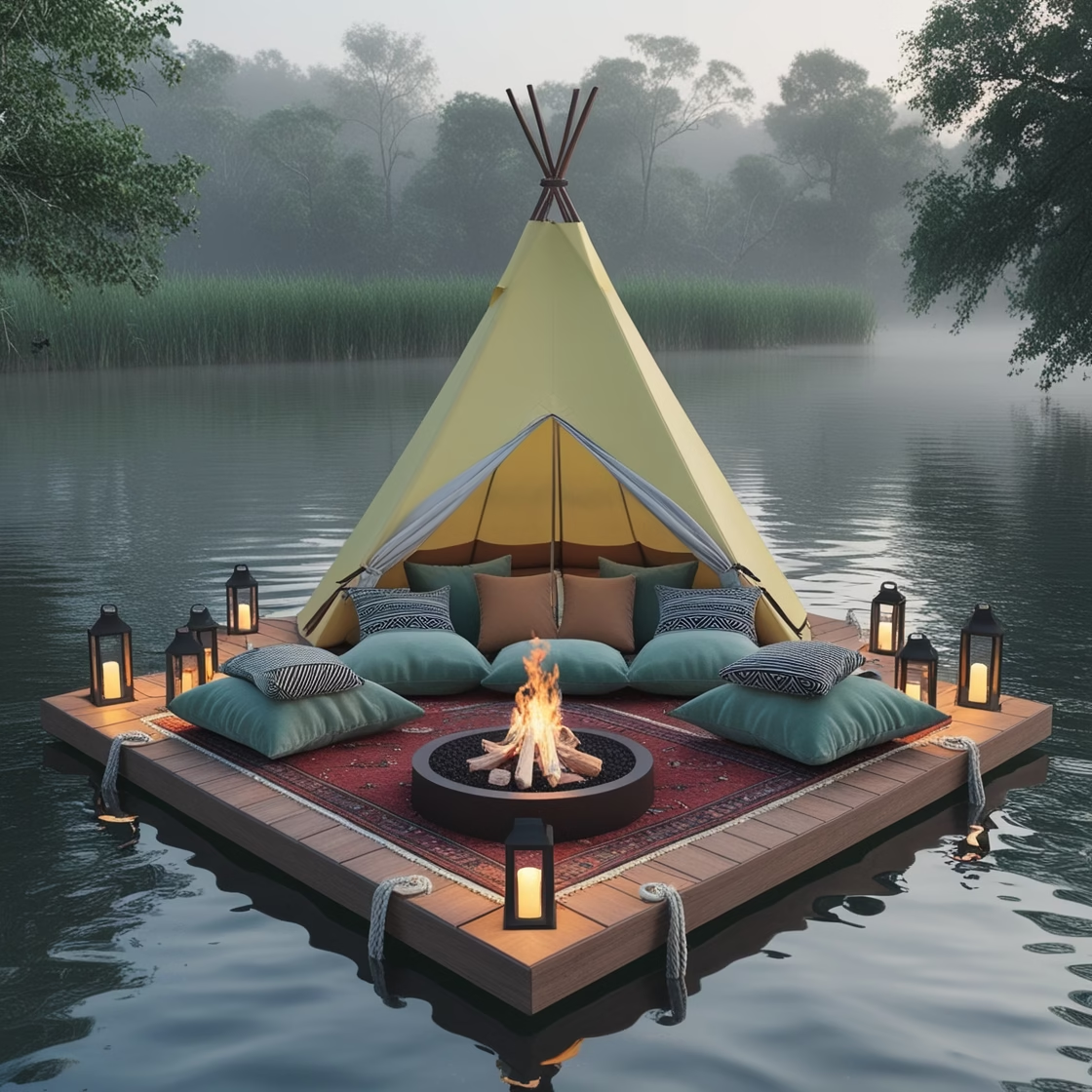
Creating a functional and comfortable setup on your floating platform is key. Here’s a step-by-step guide:
Installing Your Tent
A tent on water needs added stability and protection from water splashes. Choose a waterproof tent and add an extra tarp underneath it for additional protection. Use straps to secure the tent corners to the platform to ensure it stays in place, even with minor waves.
Arranging the Essentials
Floating campsites require careful organization, as space is limited. Here are a few organization tips:
- Use Dry Bags: To protect food, electronics, and clothing from water, store them in waterproof dry bags.
- Minimize Gear: Only pack the essentials to avoid clutter and maintain stability. Opt for lightweight camping equipment such as compact cooking gear and inflatable seating.
- Place Heavy Items Centrally: Keep heavier items like coolers and cooking equipment in the middle of the platform to prevent tipping.
Cooking and Meal Prep on a Floating Campsite
Cooking on water requires special consideration due to limited space and safety concerns. Here are a few options:
- Portable Camping Stove: A small, portable stove is ideal for cooking meals without taking up too much space. Secure the stove on a flat, stable surface to prevent tipping.
- Cold Meals and Pre-Packaged Foods: Opt for easy-to-prepare meals, like sandwiches or wraps, for quick meal options that don’t require cooking.
- Trash and Waste Management: Use a designated, secure container for trash to prevent littering the water. Dispose of waste responsibly after leaving your campsite.
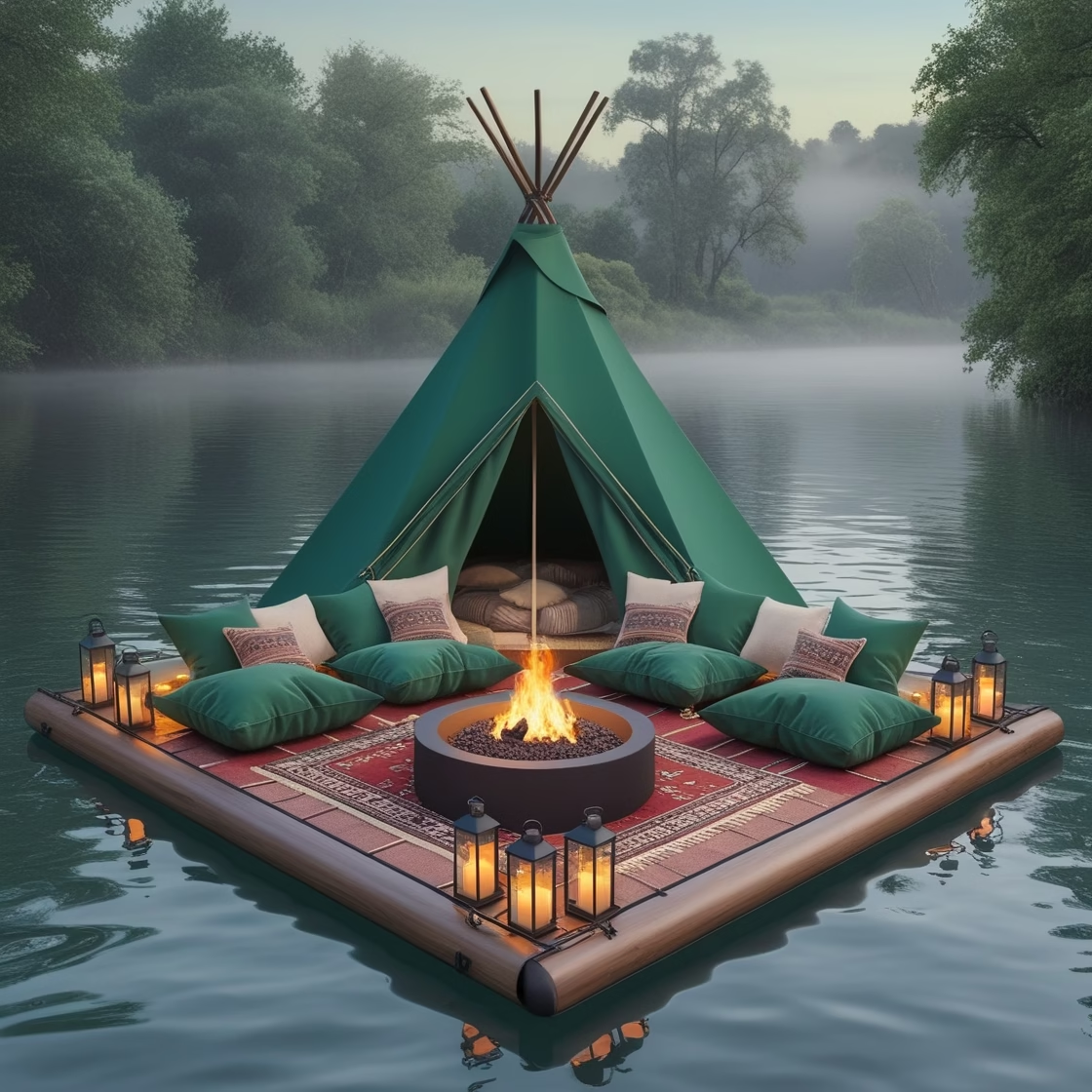
Staying Safe on a Floating Campsite
While floating campsites are exciting, they also come with unique safety considerations. Here are some critical safety tips:
Weather Precautions
Weather can change quickly on water, so monitor the forecast and avoid going out in high winds or thunderstorms. Bring weatherproof clothing, extra tarps, and a small emergency shelter in case of unexpected weather changes.
Water Safety
Since you’ll be on water, it’s essential to take extra precautions:
- Wear Life Jackets: Every camper should wear a life jacket while on the platform, especially if the water is deep or the campsite is remote.
- Emergency Supplies: Carry a first aid kit, waterproof flashlight, and a whistle for emergencies. Familiarize yourself with basic water rescue techniques in case someone falls overboard.
Wildlife Awareness
Floating campsites can attract curious wildlife. Keep food in sealed containers, avoid feeding animals, and store food and trash securely. Be mindful of local wildlife regulations and avoid areas with alligator or snake warnings.
Eco-Friendly Tips for a Floating Campsite Adventure
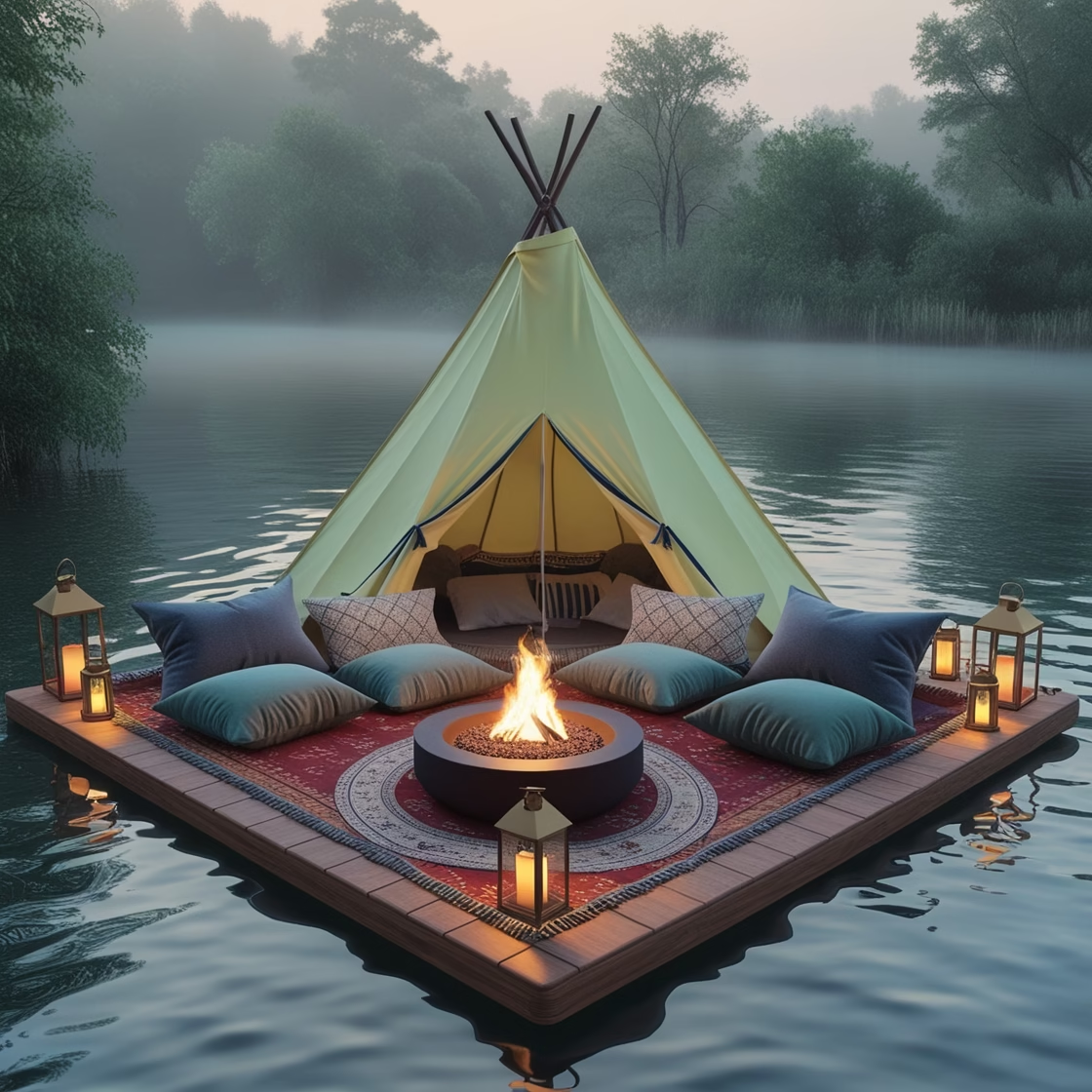
Practicing eco-friendly habits is crucial when camping on water. Here’s how to minimize your environmental impact:
- Leave No Trace: Avoid leaving any trash or belongings behind. Pack out everything you bring to your floating campsite.
- Eco-Friendly Toiletries: Use biodegradable soaps and avoid letting any toiletries enter the water directly.
- Dispose of Waste Properly: Bring back all waste and dispose of it responsibly onshore. Never throw trash or food scraps into the water.
Floating Campsite Activities: Making the Most of Your Adventure
There are plenty of activities to enjoy on a floating campsite beyond the relaxing ambiance:
Fishing
A floating campsite gives anglers easy access to fishing at all times. Bring compact fishing gear, and follow local regulations for licenses, species, and catch-and-release practices.
Swimming and Floating
Swimming from a floating campsite is a fun way to enjoy the water, but always stay within sight of the platform and use flotation devices if needed.
Stargazing
Being away from city lights makes stargazing from a floating campsite a breathtaking experience. Bring a telescope or simply lie back and enjoy the view from your platform.
Photography and Bird Watching
Capture stunning photos of water reflections, sunrise, sunset, and unique wildlife from your floating platform. Bird watchers will appreciate the proximity to waterfowl and other aquatic birds, so bring binoculars to make the most of it.
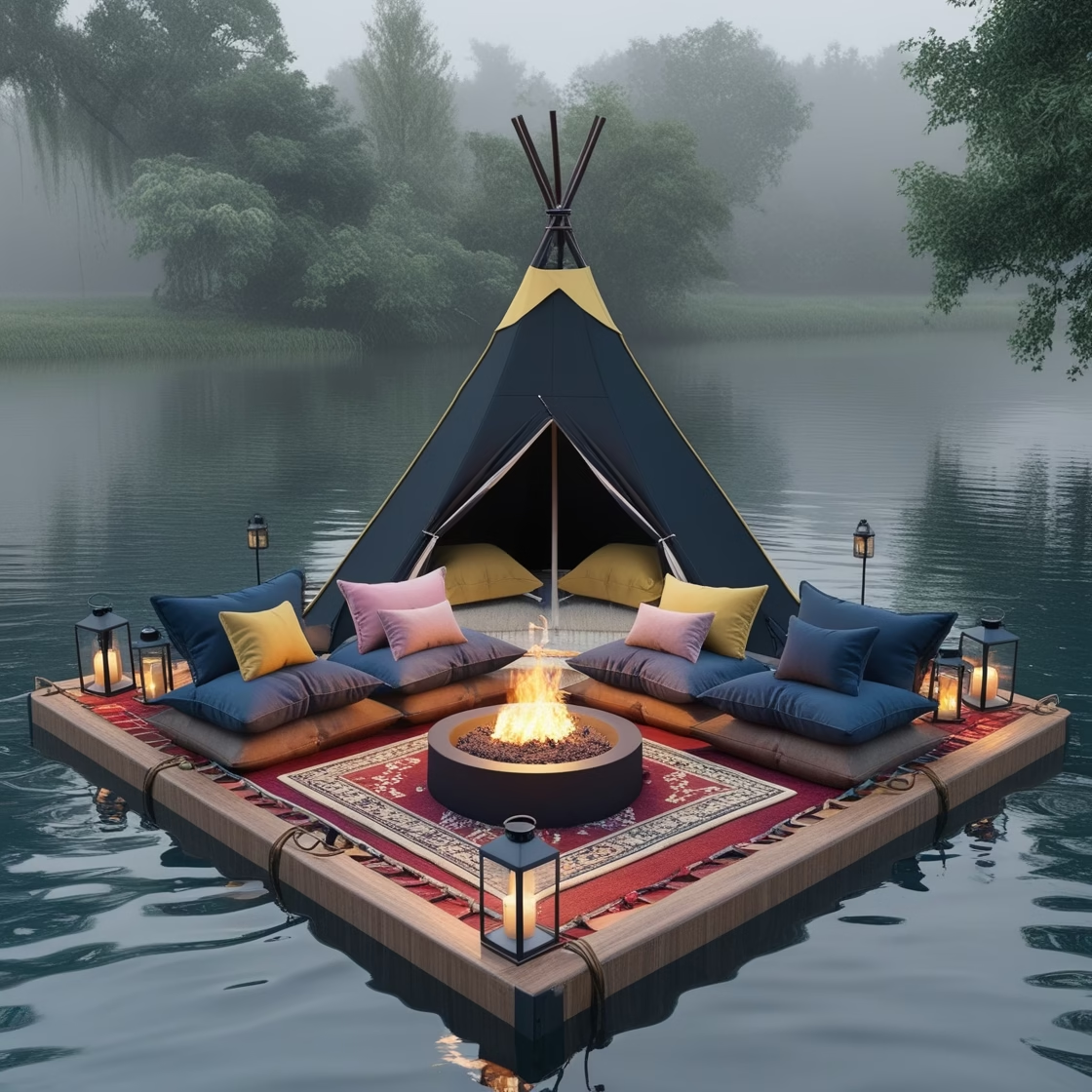
Packing List for a Floating Campsite Adventure
Here’s a quick checklist to make sure you have everything for your floating campsite adventure:
- Camping Gear: Tent, sleeping bag, tarp, pillows, dry bags
- Water Gear: Life jackets, anchor, ropes, emergency whistle
- Cooking Essentials: Portable stove, cooking utensils, food in waterproof containers
- Safety Equipment: First aid kit, flashlight, emergency shelter
- Recreational Gear: Fishing rod, binoculars, telescope
- Eco-Friendly Supplies: Biodegradable toiletries, waste bags, eco-friendly soap
Floating Campsites for Families and Groups
Floating campsites aren’t just for solo adventurers or couples; they’re also a fantastic option for families or groups looking to enjoy the outdoors together. Camping on the water provides a unique bonding experience and plenty of space for everyone to unwind and participate in activities together.
Setting Up for Larger Groups
Camping with a group requires a slightly different setup:
- Choose Larger Platforms: For groups, a pontoon boat or a series of connected inflatable platforms works well. They provide ample space, stability, and room for gear.
- Plan for Safety: Each group member, including children, should have a properly fitting life jacket and understand basic water safety.
- Group-Friendly Activities: Set up team activities like paddle boarding, fishing tournaments, and swimming relays to make the experience fun for everyone.
Kid-Friendly Floating Campsite Ideas
A floating campsite can be an unforgettable experience for kids, introducing them to nature in a way that’s engaging and educational. Here are some tips for a safe and exciting experience with children:
- Teach Water Safety First: Ensure that kids know the importance of staying on the platform, wearing life jackets, and never leaning too far over the edge.
- Hands-On Nature Activities: Bring along a small fishing net, binoculars, or a magnifying glass so kids can explore aquatic life safely.
- Create a Play Zone: Dedicate a section of the platform for safe play with floating toys and kid-friendly gear.
Choosing the Right Time for a Floating Campsite Adventure
The timing of your trip can greatly influence your floating campsite experience. Here’s how to pick the best season and weather for your water-bound camping adventure.
Seasonal Considerations
- Spring: This is a beautiful time for a floating campsite adventure as nature awakens. However, spring storms and rain are common, so check forecasts and come prepared with rain gear.
- Summer: The warmer months are ideal for swimming and spending extended time outdoors. However, be mindful of high temperatures and bring plenty of sun protection, hats, and shade covers.
- Fall: Fall offers stunning views of changing leaves, cooler temperatures, and fewer insects. It’s also a quieter time to camp as there tend to be fewer visitors, making it perfect for serene floating campsites.
- Winter: Winter floating campsites are only advisable in mild climates. Extra insulation, waterproof gear, and warm clothing are essential if you camp in cooler weather.
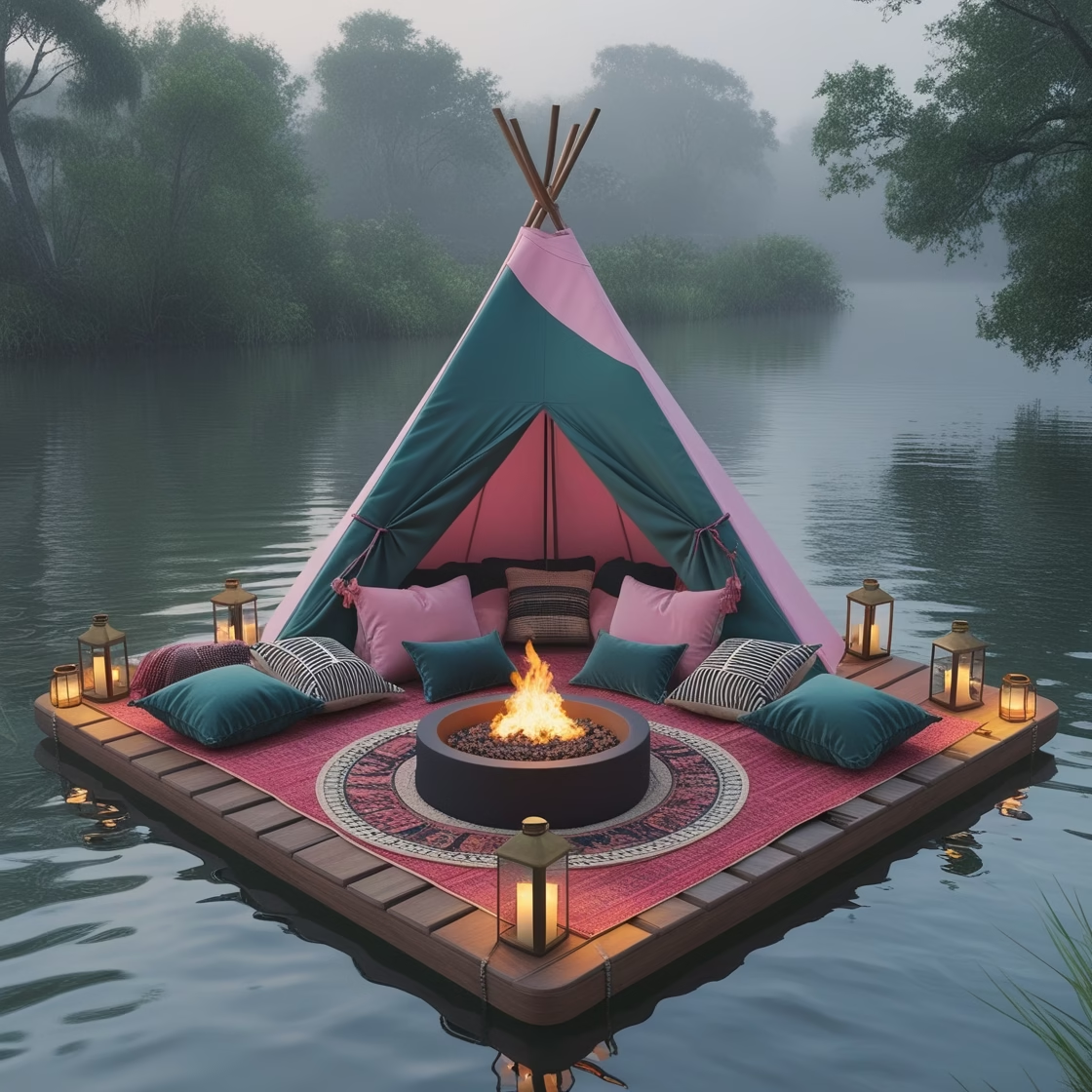
Ideal Weather Conditions
Good weather is vital for an enjoyable floating campsite experience. Here’s what to look for:
- Mild Winds: Strong winds can make it difficult to stabilize your platform. Aim for days with minimal wind for a safer experience.
- Clear Skies: Clear days allow for excellent visibility, warmth, and beautiful views. They’re also ideal for stargazing at night.
- Low Humidity: High humidity can make camping on water uncomfortable, especially in the summer. Low-humidity days are more comfortable and allow gear to dry quickly.
Sustainable Floating Campsite Tips for Eco-Conscious Campers
Keeping the water and surrounding environment clean and undisturbed is essential to the floating campsite experience. Here are some advanced eco-friendly practices to leave the water pristine:
Minimize Impact with Eco-Friendly Gear
When planning for your campsite, look for environmentally friendly and reusable gear. For example:
- Solar-Powered Lights and Chargers: Solar lights reduce the need for batteries, which can be harmful if they accidentally enter the water. Solar chargers are also a great way to keep small devices powered without leaving an environmental footprint.
- Eco-Friendly Cooking Gear: Opt for reusable or compostable utensils, plates, and bowls. Avoid single-use plastics entirely to help protect the aquatic ecosystem.
- Reusable Water Bottles and Containers: Keep plastic waste to a minimum by using refillable water bottles and containers.
Sustainable Food Choices
Food waste can have a big impact on the environment, especially in remote locations. Here are some ways to reduce waste on a floating campsite:
- Bring Compact, Low-Waste Meals: Dehydrated meals, pre-prepped foods, and snacks with minimal packaging are easy to carry and don’t create much waste.
- Pack Out Food Waste: Food scraps can attract unwanted wildlife and harm the water ecosystem. Bring bags to pack out all waste and dispose of it responsibly on land.
- Dispose of Greywater Properly: If you use water for cooking or cleaning, use a small container to store greywater and dispose of it back onshore following Leave No Trace principles.
Conclusion
A floating campsite adventure is a remarkable way to experience the serenity of nature, merging camping with the unique perspective of life on water. From selecting the right platform to setting up a safe and eco-friendly campsite, you’re now equipped to embark on a memorable journey. Whether you’re drawn to the idea of fishing at sunrise, floating under the stars, or just finding a peaceful escape, a floating campsite offers a one-of-a-kind adventure.
Prepare wisely, respect nature, and embrace the unique freedom that a floating campsite offers. Happy floating!


